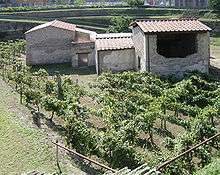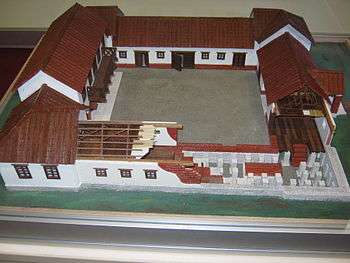Villa rustica
Villa rustica (countryside villa) was the term used by the ancient Romans to denote a villa set in the open countryside, often as the hub of a large agricultural estate (latifundium). The adjective rusticum was used to distinguish it from an urban or resort villa. The villa rustica would thus serve both as a residence of the landowner and his family (and retainers) and also as a farm management centre. It would often comprise separate buildings to accommodate farm labourers and sheds and barns for animals and crops.[1][2][3][4][5] In modern British archaeology, a villa rustica is commonly (and misleadingly) referred to simply as a "Roman villa".
The villa rustica's design differed depending on the architect, but usually it consisted of three parts; the urbana (main house), agricultural center and the rusticana (farm area).
List of Villae rusticae
Bulgaria
France
- Villa Rustica, Coustaty
- Villa Rustica, Lussas-et-Nontronneau
- Villa Rustica, Montcaret
- Villa Rustica, Montmaurin
- Villa Rustica, Petit-Bersac
- Villa Rustica, Pièce de Rance
Germany



Baden-Württemberg
- Villa Rustica, Baden-Baden-Haueneberstein, Roman settlement at Wohlfahrtsberg[6]
- Villa Rustica at Bondorf, Böblingen
- Villa rustica at Büßlingen, Konstanz
- Villa Rustica (Brombach), Lörrach
- Villa Rustica at Eigeltingen[7]
- Villa Rustica at Gaggenau-Bad Rotenfels / Oberweier[8]
- Villa urbana at Grenzach-Wyhlen (Museum Römervilla)
- Villa rustica at Hechingen-Stein, Zollernalbkreis
- Villa urbana at Heitersheim
- Villa Rustica (Meßkirch), Sigmaringen
- Villa Rustica at Hirschberg[9]
- Villa Rustica (Inzigkofen), Sigmaringen
- Villa Rustica at Karlsruhe-Durlach[10]
- Villa Rustica at Langenau[11]
- Villa Rustica (Laucherthal), Sigmaringen
- Villa Rustica (Lauffen), Heilbronn
- Villa Rustica at Mühlacker[12]
- Villa Rustica at Nagold[13][14]
- Villa Rustica (Nürtingen)
- Villa Rustica at Oberndorf-Bochingen[15][16]
- Villa Rustica (Rommelshausen), Rems-Murr-Kreis
- Römerbad (Weinsberg), Heilbronn
- Villa Rustica (Wiesenbach/Baden), Rhein-Neckar-Kreis
- Römisches Bad (Wurmlingen), Tuttlingen
- Villa Rustica (Zimmerhof), Heilbronn
- Villa Rustica Bietigheim-Weilerlen at Bietigheim-Bissingen, Ludwigsburg
Bavaria
- Villa Rustica (Burgweinting)
- Villa rustica (Denning), Stadt München
- Villa Rustica (Friedberg)
- Villa Rustica at Großberghofen, Dachau
- Villa Rustica (Holheim), Donau-Ries
- Villa Rustica at Hüssingen[17]
- Villa Rustica Kohlhunden, Ostallgäu[18]
- Villa Rustica (Leutstetten), Stadt Starnberg
- Villa Rustica (Möckenlohe) (Naturpark Altmühltal)[19][20]
- Villa Rustica (Nassenfels), Eichstätt
- Villa Rustica (Niederndorf), Freising
- Villa Rustica (Oberndorf)
- Villa Rustica (Oberhaunstadt), Ingolstadt
- Villa Rustica (Peiting), Weilheim-Schongau[21][22]
- Villa Rustica (Stadtbergen)
- Villa Rustica (Zipfwang), Oberallgäu
Hesse
- Groß-Umstadt-Heubach, Wamboltsches Schlösschen
- Haselburg Roman villa, Odenwald
- Rodau, Zwingenberg, "Kleine Weide"[23]
Northrhine-Westphalia
- Villa rustica (Blankenheim (Ahr))[24]
- Villae Rusticae at Eschweiler, Aachen
- Propsteier Villa, Eschweiler, Aachen
- Villae Rusticae near Hambach surface mine, Düren
- Villa rustica (Nettersheim-Roderath) at Sollig, Nettersheim-Roderath, Euskirchen
Rheinland-Palatine

- Villa rustica Weilberg, Bad Dürkheim-Ungstein]]
- Römerhalle (Bad Kreuznach), Bad Kreuznach
- Roman Villa of Bad Neuenahr-Ahrweiler
- Villa rustica (Bollendorf), Eifelkreis Bitburg-Prüm
- Villa Otrang, Fließem, Eifelkreis Bitburg-Prüm
- Villa Rustica at Sarresdorf (Gerolstein)[25]
- Villa Rustica (Kempten bei Bingen), Mainz-Bingen
- Villa Rustica at Herschweiler-Pettersheim, Kusel[26]
- Roman estate at Lösnich
- Villa Urbana in Longuich
- Villa Rustica (Mehring) (Mosel), Trier-Saarburg
- Villa rustica (Wachenheim)
- Villa Rustica (Weiler bei Bingen), Mainz-Bingen
- Villa rustica (Wasserliesch), Trier-Saarburg
Saarland
- Roman Villa Borg
- Reinheim
- Roman villa at Nennig

Italy
Portugal
- Boca do Rio
- Castelo da Lousa
- Villa of Fonte do Milho
- Milreu
- Villa of Rabaçal
- Villa of São Cucufate
- Tower of Centum Cellas
- Villa of Torre de Palma
- Villa of Cerro da Vila
Serbia
Switzerland
Aargau
- Villa Rustica (Bellikon)
- Villa Rustica (Oberentfelden)
- Villa Rustica (Oberlunkhofen)
- Villa rustica (Zofingen)
Basel-Landschaft
- Villa Rustica (Bennwil)
- Villa Rustica (Munzach)
Genf
- Villa Rustica (Bernex)
Jura
- Villa Rustica (Vicques JU)
Solothurn
- Villa rustica (Biberist-Spitalhof)
Waadt
- Villa romaine du Prieuré
Zürich
- Irgenhausen Castrum (built on the remains of a former villa rustica)
- Villa in Wetzikon - Kempten[28]
- Villa Rustica (Buchs)
- Villa Rustica (Kloten)
- Villa Rustica (Oberweningen)
- Villa Rustica (Seeb)
Turkey
United Kingdom
- Bignor Roman Villa
- Borough Hill Roman villa
- Brading Roman Villa
- Chedworth Roman Villa
- Crofton Roman Villa
- Fishbourne Roman Palace
- Gadebridge Park Roman Villa
- Littlecote Roman Villa
- Llantwit Major Roman Villa
- Low Ham Roman Villa
- Lullingstone Roman Villa
- Newport Roman Villa
- Piddington Roman Villa
- Woodchester Roman Villa
References
- ↑ Annalia Marzano: Roman villas in central Italy: a social and economic history. Brill 2007, ISBN 978-90-04-16037-8 (restricted online copy at Google Books)
- ↑ Alfred Frazer: The Roman villa: villa urbana. UPenn Museum of Archaeology 1998, ISBN 978-0-924171-59-8 (restricted online copy at Google Books)
- ↑ Alexander Gordon McKay: Houses, villas, and palaces in the Roman world . JHU Press 1998, ISBN 978-0-8018-5904-5 (restricted online copy at Google Books)
- ↑ John T. Smith: Roman Villas. A Study in Social Structure. Routledge, London, 1997. ISBN 0-415-16719-1
- ↑ John Percival: The Roman Villa. A Historical Introduction. Batsford, London, 1988 (Paperback)
- ↑ Die Römer am Wolfartsberg. (Heimatblätter des Heimat- und Kulturvereines Haueneberstein e.V., Nr. 3). haueneberstein.de Archived February 11, 2015, at the Wayback Machine.
- ↑ eigeltingia.de
- ↑ Gerhard Hoffmann: Spuren früher Zeiten – Funde und Fundstätten im Landkreis Rastatt. Eine Materialkunde zur Vor und Frühgeschichte. Bestandsaufnahme und Dokumentation. (Sonderveröffentlichungen des Kreisarchivs Rastatt, Band 5). Verlag Regionalkultur, Ubstadt-Weiher u. a. 2007, ISBN 978-3-89735-495-1. (Abstract) Archived March 18, 2015, at the Wayback Machine.
- ↑ gastgeber-hessen.de
- ↑ ka.stadtwiki.net
- ↑ archaeologie-bw.de
- ↑ muehlacker.de
- ↑ nagold.de
- ↑ naturparkschwarzwald.de Archived February 28, 2014, at the Wayback Machine.
- ↑ archaeologie-bw.de
- ↑ denkmalpflege-bw.de
- ↑ Informationszentrum Naturpark Altmühltal in Trägerschaft des Landkreises Eichstätt. "Römischer Bauernhof". Retrieved 2015-07-05.
- ↑ kaluwi.de
- ↑ roemervilla-moeckenlohe.de
- ↑ altmuehltal.de Archived February 21, 2014, at the Wayback Machine.
- ↑ Tourismusverband Pfaffenwinkel. "Villa Rustica Peiting". Retrieved 2015-07-05.
- ↑ Alpenland in Römerhand. "Peiting". Retrieved 2015-06-02.
- ↑ morgenweb.de
- ↑ roemervilla-blankenheim.de Archived February 24, 2015, at the Wayback Machine.
- ↑ roscheiderhof.de
- ↑ kuseler-musikantenland.de
- ↑ Rimski lokaliteti valjevskog kraja Archived April 16, 2016, at the Wayback Machine.
- ↑ Horisberger, Beat; Hedinger, Bettina; Hoek, Florian; Büsser, Roger (2007). Römisches Landleben im Zürcher Oberland - Die Römer in Wetzikon (in German). Frauenfeld, Stuttgart, Wien: Verlag Huber. ISBN 978-3-7193-1441-5.
External links
- villa rustica - open-air museum at Hechingen (Germany)
